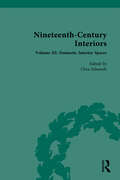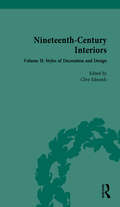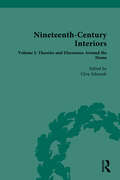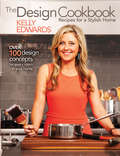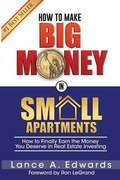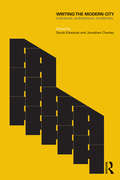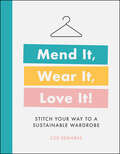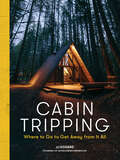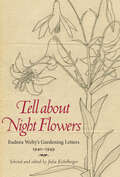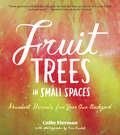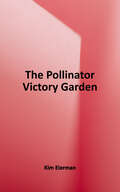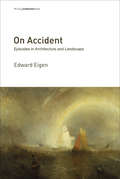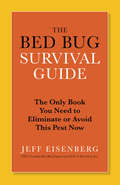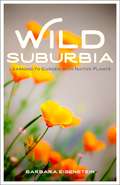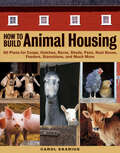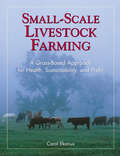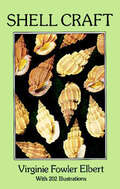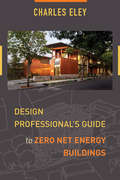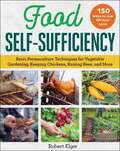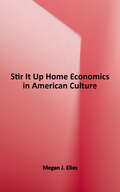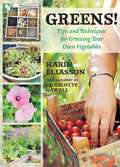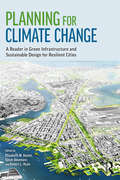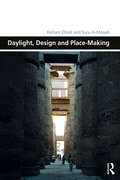- Table View
- List View
Nineteenth-Century Interiors: Volume III: Domestic Interior Spaces
by Clive EdwardsThis volume of primary source materials documents the spatial layouts of the nineteenth century home as they often became more precisely planned with rooms for specific purposes being developed. The styles began to truly reflect the owner’s taste and position. The range is of course vast from single room dwellings to large-scale mansions and numerous variations in-between. Accompanied by extensive editorial commentary, this collection will be of great interest to students and scholars of art history.
Nineteenth-Century Interiors: Volume II: Styles of Decoration and Design
by Clive EdwardsThis volume of primary source materials documents the nineteenth-century search for a representative style, and the alternating fashions for interiors that demonstrated the consumerism of the period. Although in some senses every interior is unique so that a style canon may seem to be meaningless, there have been important historical trends or styles that have influenced individual interiors, and these have formed the groundwork from which other styles and tastes have developed and changed. Accompanied by extensive editorial commentary, this collection will be of great interest to students and scholars of art history.
Nineteenth-Century Interiors: Volume I: Theories and Discourses Around the Home
by Clive EdwardsThis volume of primary source materials documents the nature of the home and the theories and discussions around the concept. It examines the class divisions that become evident with the ostentatious lifestyles of political and society hostesses at the peak, whilst middle-class housing often in suburbia, seemed to have created a separation of home and work, arguably suggesting men and women lived in separate spheres. Working-class interiors, often seen the eyes of middle-class observers, were at the bottom of the hierarchy and often reflected concerns of social inequality and misery. The documents also address the process of purchasing and decorating a home, advice on decoration and home management, the nature of taste and comfort, and the symbolic roles of the home as an anchor in society. Accompanied by extensive editorial commentary, this collection will be of great interest to students and scholars of art history.
The Design Cookbook: Recipes for a Stylish Home
by Kelly EdwardsThrough stunning photographs and step-by-step instructions, designer and lifestyle expert Kelly Edwards brings a myriad of looks, tastes, and approaches to chic home design in this guidebook. From the kitchen and the bedroom to the home office and the out-of-doors, Kelly illustrates how to achieve the best color, texture, proportion, and overall design aesthetic and passes along decorating tips from amazing designers and tastemakers. Individual chapters contain a wide array of images and inspiration for the respective spaces along with an assortment of do-it-yourself “recipes” to achieve just the right personality
How to Make Big Money in Small Apartments: How to Finally Earn the Money You Deserve in Real Estate Investing
by Lance Edwards Ron LeGrandThis book reveals how anyone can skip the competition and get started with small apartments - whether new or experienced. Through detailed explanation and over 40 case studies, you'll learn how to make money by wholesaling, buying, and/or rehabbing small apartment buildings - using none of your own cash or credit, and with no prior experience. You will discover the step-by-step approaches for finding deals, qualifying deals, finding buyers, finding investors and monetizing your small apartment deals; plus how to scale-up to larger apartments. This book contains the know-how and the motivation for you to jump to the fast lane and start doing small apartment deals now. Since 2002, when he bought his first small apartment nothing-down, Lance Edwards has done apartment deals ranging from 3 units to nearly 300 units. And since 2007, he's also been teaching others how to escape the rat race faster and play bigger - by starting with small apartments.
Writing the Modern City: Literature, Architecture, Modernity
by Sarah Edwards Jonathan CharleyLiterary texts and buildings have always represented space, narrated cultural and political values, and functioned as sites of personal and collective identity. In the twentieth century, new forms of narrative have represented cultural modernity, political idealism and architectural innovation. Writing the Modern City explores the diverse and fascinating relationships between literature, architecture and modernity and considers how they have shaped the world today. This collection of thirteen original essays examines the ways in which literature and architecture have shaped a range of recognisably ‘modern’ identities. It focuses on the cultural connections between prose narratives – the novel, short stories, autobiography, crime and science fiction – and a range of urban environments, from the city apartment and river to the colonial house and the utopian city. It explores how the themes of memory, nation and identity have been represented in both literary and architectural works in the aftermath of early twentieth-century conflict; how the cultural movements of modernism and postmodernism have affected notions of canonicity and genre in the creation of books and buildings; and how and why literary and architectural narratives are influenced by each other’s formal properties and styles. The book breaks new ground in its exclusive focus on modern narrative and urban space. The essays examine texts and spaces that have both unsettled traditional definitions of literature and architecture and reflected and shaped modern identities: sexual, domestic, professional and national. It is essential reading for students and researchers of literature, cultural studies, cultural geography, art history and architectural history.
Mend It, Wear It, Love It!: Stitch Your Way to a Sustainable Wardrobe
by Zoe EdwardsA practical tool kit for mending and upcycling your wardrobe.It's &“sew&” simple to give your wardrobe an eco-chic edge! With fast fixes and clever techniques, this accessible, fully illustrated sewing book has everything you need to mend, customize and care for your clothes.Parting with damaged, yet beloved, clothes can be one of the saddest things, but what if you were able to fix those holes, give them a fresher look, and extend their life? Luckily, with this guide to mending and patching, you don&’t have to say goodbye to your favorite clothing items ever again!Now you can cherish all your garments, even those in the furthest corner of your closet! This sewing book for beginners will help you master the skills to repair a seam and mend a hem, even if you&’ve never touched a needle and thread before!Enjoy Your Clothes for LongerThis sewing book arms you with the techniques you need to enjoy your clothes for longer and express your creativity. Detailed step-by-step illustrations and clear instructions explain how to sew, repurpose, and care for your clothes in a range of materials. For anyone who cares about reducing fashion waste but doesn't want to sacrifice style, this is the book for you! It addresses the way mending is great for fashion sustainability and gives you the low down on &“fast fashion&”. From polluting ecosystems and breeding unsafe work environments, discover the huge human and environmental impacts those irresistibly cheap t-shirts have.The Art of Mending and Sewing Mend It. Wear It. Love It is for everyone! Packed full of simple fixes, as well as more advanced techniques, this book is perfect for sewers, crafters, and fashion lovers of all experience levels.
Cabin Tripping: Where to Go to Get Away from It All
by JJ EggersA mountain lodge 5,000 feet up in Washington State&’s Cascades mountains, accessible only by skis—or an SUV tricked out with bulldozer-size snow tires. A sleek cabin just 80 minutes from Manhattan, overlooking the property&’s pond and 19 acres of woodland. A romantic, eco-friendly escape in the misty mountains of Bali&’s Gunung Agung volcano. A glass-domed Finnish hut offering unobstructed views of the Northern Lights. Whether readers are seeking a once-in-a-lifetime adventure or a quiet retreat, a cozy night around a firepit or a summery lakefront sojourn, Cabin Tripping delivers. Divided into six chapters—Forest, Tropics, Mountain, Arctic, Water, and Desert—the book features a curated collection of over 80 of the most incredible cabins available to rent all over the globe. Each cabin profile includes information on how to get there, activities to enjoy in the area (hiking trails, fishing holes, thermal spas, and more), and tips like when to plan your visit to maximize your &“leaf-peeping&” or whale-watching opportunities.
Eating the Alphabet: Fruits & Vegetables from A to Z
by Lois EhlertA vibrant and sturdy word book starring fruits and vegetables from around the world from Caldecott Honor–winning author-illustrator Lois Ehlert. Features upper- and lowercase letters for preschoolers just learning language.Each turn of the page reveals a mouth-watering arrangement of foods: Indian corn, jalapeno, jicama, kumquat, kiwifruit and kohlrabi. Lois Ehlert's lively watercolors paired with bold easy-to-read type make for a highly appealing and accessible book for parents and children to devour.At the end of the book, Ehlert provides a detailed glossary that includes pronunciation, botanical information, the origin and history of the particular plant and occasional mythological references, with a small watercolor picture to remind the reader of what the plant looks like.Apple to Zucchini,come take a look.Start eating your waythrough this alphabet book.
Planting a Rainbow (Fountas & Pinnell LLI Blue: Level F)
by Lois EhlertThis educational and enjoyable book helps children understand how to plant bulbs, seeds, and seedlings, and nurture their growth. Lois Ehlert's bold collage illustrations include six pages that present all the flowers of each color of the rainbow.
Tell about Night Flowers: Eudora Welty's Gardening Letters, 1940-1949
by Julia EichelbergerTell about Night Flowers presents previously unpublished letters by Eudora Welty, selected and annotated by scholar Julia Eichelberger. Welty published many of her best-known works in the 1940s: A Curtain of Green, The Wide Net, The Robber Bridegroom, Delta Wedding, and The Golden Apples. During this period, she also wrote hundreds of letters to two friends who shared her love of gardening. One friend, Diarmuid Russell, was her literary agent in New York; the other, John Robinson, was a high school classmate and an aspiring writer who served in the Army in WWII, and long the focus of Welty's affection. Welty's lyrical, witty, and poignant discussions of gardening and nature are delightful in themselves; they are also figurative expressions of Welty's views of her writing and her friendships. Taken together with thirty-five illustrations, they form a poetic narrative of their own, chronicling artistic and psychic developments that were underway before Welty was fully conscious of them. By 1949 her art, like her friendships, had evolved in ways that she would never have predicted in 1940. Tell about Night Flowers not only lets readers glimpse Welty in her garden; it also reveals a brilliant and generous mind responding to the public events, people, art, and natural landscapes Welty encountered at home and on her travels during the 1940s. This book enhances our understanding of the life, landscape, and art of a major American writer.
Fruit Trees in Small Spaces: Abundant Harvests from Your Own Backyard
by Colby EiermanLuscious peaches, crisp apples, and sweet plums right off the tree are hard to beat. For gardeners yearning for the pleasures of home-grown fruit plucked straight from the tree, this deliciously encouraging guide cuts the subject down to size. Colby Eierman, garden designer and fruit expert, shows how trees can easily be tucked into the tiniest spots and still yield a bumper crop of gorgeous fruit. Fruit Trees in Small Spaces covers everything a gardener needs to know about choosing and nurturing the most delicious small-space varieties, including selection, pruning, training, irrigation, and disease prevention. With inspiring ideas for spaces of all shapes and sizes and creative recipes for your incredible harvest, you'll want to plant a mini-orchard in every intimate corner. For the gardener with space limitations, bountiful fruit trees are now within arm's reach.
The Pollinator Victory Garden: Win the War on Pollinator Decline with Ecological Gardening: How to Attract and Support Bees, Beetles, Butterflies, Bats, and Other Pollinators
by Kim EiermanThis book explains about how you can create a beautiful landscape that attracts and supports many different species of pollinators.
On Accident: Episodes in Architecture and Landscape (Writing Architecture)
by Edward EigenEngaging essays that roam across uncertain territory, in search of sunken forests, unclassifiable islands, inflammable skies, plagiarized tabernacles, and other phenomena missing from architectural history.This collection by “architectural history's most beguiling essayist” (as Reinhold Martin calls the author in the book's foreword) illuminates the unfamiliar, the arcane, the obscure—phenomena largely missing from architectural and landscape history. These essays by Edward Eigen do not walk in a straight line, but roam across uncertain territory, discovering sunken forests, unclassifiable islands, inflammable skies, unvisited shores, plagiarized tabernacles. Taken together, these texts offer a group portrait of how certain things fall apart.We read about the statistical investigation of lightning strikes in France by the author-astronomer Camille Flammarion, which leads Eigen to reflect also on Foucault, Hamlet, and the role of the anecdote in architectural history. We learn about, among other things, Olmsted's role in transforming landscape gardening into landscape architecture; the connections among hedging, hedge funds, the High Line, and GPS bandwidth; timber-frame roofs and (spider) web-based learning; the archives of the Houses of Parliament through flood and fire; and what the 1898 disappearance and reappearance of the Trenton, New Jersey architect William W. Slack might tell us about the conflict between “the migratory impulse” and “love of home.” Eigen compares his essays to the “gathering up of seeds that fell by the wayside.” The seedlings that result create in the reader's imagination a dazzling display of the particular, the contingent, the incidental, and the singular, all in search of a narrative.
The Bed Bug Survival Guide: The Only Book You Need to Eliminate or Avoid This Pest Now
by Jeff EisenbergThe 5 year old who carried them home in his backpack thta he grabbed from the communal pile at school...The young assistant who got them from her new work cubicle...the executive who got them on an overseas flight...It can no longer be denied that the city, the country and the world are in the grips of this epidemic. Jeff Eisenberg and his NYC-based company Pest Away have successfully treated more than 100,000 spaces for bed bugs over the past 15 years. He's the go-to guy for businesses, celebs, and the media--and in THE BED BUG SURVIVAL GUIDE he shares his best strategies, advice and tips for treating and preventing bed bug infestation once and for all.With Eisenberg's advice, readers can lower thier risk of bed bug infestation by up to 60%! Or, if they have them they can be sure they are using the right method to get rid of them. The book is divided into ten user-friendly chapters that cover everything, including: Prevention--what to do immediately, daily, weekly and monthly Travel--the 5 biggest mistakes made during hotel stays Life--avoiding bed bugs in unexpected places like the gym, the mall, the movie theater, and on airplanes Treatment--Green? Heat? Cryonite? Fumigation of furniture? Exterminators--hiring one who actually knows what to do.
Wild Suburbia: Learning to Garden with Native Plants
by Barbara EisensteinWild Suburbia guides us through the process of transforming a traditional, high water-use yard into a peaceful habitat garden abounding with native plants. Author Barbara Eisenstein emphasizes that gardening is a rewarding activity rather than a finished product, from removing lawns and getting in touch with a yard's climate to choosing plants and helping them thrive. Supplementing her advice with personal stories from her decades of experience working with native plants, Eisenstein illuminates the joys of tending a native garden-and assures us that any challenges, from managing pests to disapproving neighbors, should never sap the enjoyment out of a pleasurable and fulfilling hobby. For plant lovers curious about their own ecosystems, Wild Suburbia offers a style of gardening that nurtures biodiversity, deepens connection to place, and encourages new and seasoned gardeners alike to experiment and have fun.
How to Build Animal Housing: 60 Plans for Coops, Hutches, Barns, Sheds, Pens, Nestboxes, Feeders, Stanchions, and Much More
by Carol EkariusWith dozens of adaptable plans for sheds, coops, hutches, multipurpose barns, windbreaks, and shade structures, this guide covers everything you need to know to build safe and sturdy housing for your animals. Stressing the importance of evaluating your goals, planning ahead, and budgeting accordingly, Carol Ekarius helps you determine the best structure for your particular situation and offers expert advice on tools and construction techniques. Build a functional and comfortable house for your animals that they’ll be proud to call home.
Small-Scale Livestock Farming: A Grass-Based Approach for Health, Sustainability, and Profit
by Carol EkariusFull of practical everyday advice, this guide explains how a natural, organic approach to livestock farming produces healthy animals, reduces costs, and increases your operation&’s self-sufficiency. Livestock expert Carol Ekarius helps you create a viable farm plan, choose suitable livestock, care for your animals&’ health, and confidently manage housing, fencing, and feeding. Case studies of successful farmers provide inspiration as you learn everything you need to know to run a prosperous livestock farm and make the lifestyle of your dreams a reality. This publication conforms to the EPUB Accessibility specification at WCAG 2.0 Level AA.
Shell Craft
by Virginie Fowler ElbertSince ancient times, seashells have provided both materials and design inspiration for a variety of arts and crafts. Shell-inspired motifs have turned up in pottery and floor mosaics, as architectural ornaments, and on furniture. The magnificent mollusks have also been used as money and decorative objects to adorn the body. This comprehensive guide by Virginie Fowler Elbert -- noted author, crafter, and authority on shell lore -- offers a wealth of craft ideas for using these lovely treasures from the sea.Following a fascinating introduction to the use of shells throughout history, the simply written text provides step-by-step instructions for cleaning, preparing, and displaying shells; suggests methods for decorating boxes and mirror frames; and shows how to create fanciful soap dishes, night lights, and jewelry items -- from pendants and necklaces to bracelets, cuff links, and earrings.You'll also find easy-to-follow directions for preserving shells in resin to make paperweights, napkin holders, cachepots, and other household accessories, as well as instructions for casting shell forms from molds (an ideal way to develop multiple patterns if only a few shells are available). There's even a chapter on how to do shell printing with linoleum blocks and crayon prints to create distinctive designs for placemats, wall hangings, wrapping paper, and stationery. Reference works and an updated list of supply sources round out this profusely illustrated guide to a fun-filled and rewarding pastime.
Design Professional's Guide to Zero Net Energy Buildings
by Charles EleyIn the United States, direct energy use in buildings accounts for 39% of carbon dioxide emissions per year--more than any other sector. Buildings contribute to a changing climate and warming of the earth in ways that will significantly affect future generations. Zero net energy (ZNE) buildings are a practical and cost-effective way to reduce our energy needs, employ clean solar and wind technologies, protect the environment, and improve our lives. Interest in ZNE buildings, which produce as much energy as they use over the course of a year, has been growing rapidly.In the Design Professional's Guide to Zero Net Energy Buildings, Charles Eley draws from over 40 years of his own experience, and interviews with other industry experts, to lay out the principles for achieving ZNE buildings and the issues surrounding their development. Eley emphasizes the importance of building energy use in achieving a sustainable future; describes how building energy use can be minimized through smart design and energy efficiency technologies; and presents practical information on how to incorporate renewable energy technologies to meet the lowered energy needs. The book identifies the building types and climates where meeting the goal will be a challenge and offers solutions for these special cases. It shows the reader, through examples and explanations, that these solutions are viable and cost-effective.ZNE buildings are practical and cost-effective ways to address climate change without compromising our quality of life. ZNE buildings are an energizing concept and one that is broadly accepted yet, there is little information on what is required to actually meet these goals. This book shows that the goal is feasible and can be practically achieved in most buildings, that our construction industry is up to the challenge, and that we already have the necessary technologies and knowledge.
Food Self-Sufficiency: Basic Permaculture Techniques for Vegetable Gardening, Keeping Chickens, Raising Bees, and More
by Robert ElgerA practical back-to-basics guide to achieving food security and financial independence. What if you could really raise or grow all the food your family needs? In this fully illustrated book, you&’ll learn to create an autonomous, diversified, and sustainable garden and to cultivate and maintain it following the main principles of permaculture. If you want to move towards greater food autonomy and you have sufficient space, you can also grow grains, keep chickens, and have a few beehives. Design and grow a prolific organic vegetable gardenLearn how to save seeds from one year to the nextDiscover techniques for collecting waterRead about beekeeping tools and how to use themLearn about chicken breeds and how to keep your birds healthy and happy Gaining food autonomy means depending less on grocery stores and food supply chains. But it is also offers the pleasure of eating healthy and delicious products straight from your land, while respecting the environment.
Stir It Up: Home Economics in American Culture
by Megan J. EliasFor Americans who came of age in the mid-twentieth century, home economics conjures memories of burnt toast and sewing disasters. But as historian Megan Elias shows in Stir It Up, home economics began as an idealistic reform movement in higher education in the early 1900s. Leaders of this movement sought to discover and disseminate the best methods for performing domestic work while creating new professional options for women that were based on elements of home life. Home and family were treated as subjects for scientific analysis; students wore lab coats while baking bread and performed rigorous tests on the palatability of their work. The Federal Bureau of Home Economics supplied a grateful audience with informational bulletins as Americans seemed to accept the idea that home could be a site for social change. <p><p>A major shift occurred in the 1950s, when new ideas about women's roles seemed to divert home economics into more traditional channels, and "home ec" became identified with the era's conformist culture. Even as home economists were redefining family dynamics and influencing government policies, such as school lunch programs, their field was becoming an object of scorn, especially to the feminists of the 1960s. Stir It Up explains what the successes and failures of home economists can tell us about American culture. The book concludes with an examination of contemporary attitudes toward domesticity, putting the phenomena of Martha Stewart, Rachael Ray, Ty Pennington, and the "Mommy Wars" into historical context.
Greens!: Tips and Techniques for Growing Your Own Vegetables
by Karin Eliasson Charlotte GawellGardening is on the rise as the desire for fresh, delicious homegrown vegetables grows. Growing your own vegetables is an easy hobby for a variety of lifestyles, as it doesn’t take a large amount of space to yield nutritious carrots or lettuce. All it takes is a bit of passion, care, and knowledge, and the rewards are soon there to enjoy.Both down-to-earth and inspirational, Swedish gardener Karin Eliasson describes the charm of growing your own vegetables. Karin runs a kitchen garden and guesthouse in Spain, but her tips are adapted to suit most climates and soil types. In this gardening guide, she gives advice on how to grow, harvest, and store over 100 different vegetable varieties and suggests easy recipes you can use in your own kitchen. With instructive and beautiful photographs, she explains the step-by-step principles of organic gardening—soil, plant feeding, digging, hoeing, and watering—and shows how to combine blooming flowers and vegetables in attractive, colorful mixes to attract garden-friendly insects.This book will not only arm you with the knowledge you need to get started, but also provide experienced and budding gardeners alike with a source for inspiration while they enjoy the beautiful photographs and tips on garden design.
Planning for Climate Change: A Reader in Green Infrastructure and Sustainable Design for Resilient Cities
by Elisabeth M. Hamin Infield Yaser Abunnasr Robert L. RyanThis book provides an overview of the large and interdisciplinary literature on the substance and process of urban climate change planning and design, using the most important articles from the last 15 years to engage readers in understanding problems and finding solutions to this increasingly critical issue. The Reader’s particular focus is how the impacts of climate change can be addressed in urban and suburban environments—what actions can be taken, as well as the need for and the process of climate planning. Both reducing greenhouse gas emissions as well as adapting to future climate are explored. Many of the emerging best practices in this field involve improving the green infrastructure of the city and region—providing better on-site stormwater management, more urban greening to address excess heat, zoning for regional patterns of open space and public transportation corridors, and similar actions. These actions may also improve current public health and livability in cities, bringing benefits now and into the future. This Reader is innovative in bringing climate adaptation and green infrastructure together, encouraging a more hopeful perspective on the great challenge of climate change by exploring both the problems of climate change and local solutions.
Daylight, Design and Place-Making (Design and the Built Environment)
by Hisham Elkadi Sura Al-MaiyahDaylight, Design and Place-Making examines the role of daylight in creating and revealing the wonders of heritage and contemporary architecture. Shifting from a purely technical approach to daylighting, this book places importance on the creation of meaningful aesthetics through an understanding of context and culture. Cultural applications of light in architecture differ depending on various historical, technological, and social characteristics. Increasingly, there is a revival of interest in contemporary architecture using daylight as an essential contextual ingredient in the design process. By examining the architecture of daylight in different locales and setting these in their historical contexts, the book argues that appropriate use of daylight will ensure not only visual and thermal comfort in the urban setting and aid in energy efficiency, but also will contribute to the overall identity of new buildings, particularly in urban regeneration projects. This book brings together an analysis of technical aspects of daylight performance and environmental impact, with discussions on the psychology of daylighting and its influence in shaping perceptions of our built environment. It will be an ideal read for academics and researchers interested in architecture and cultural studies.
